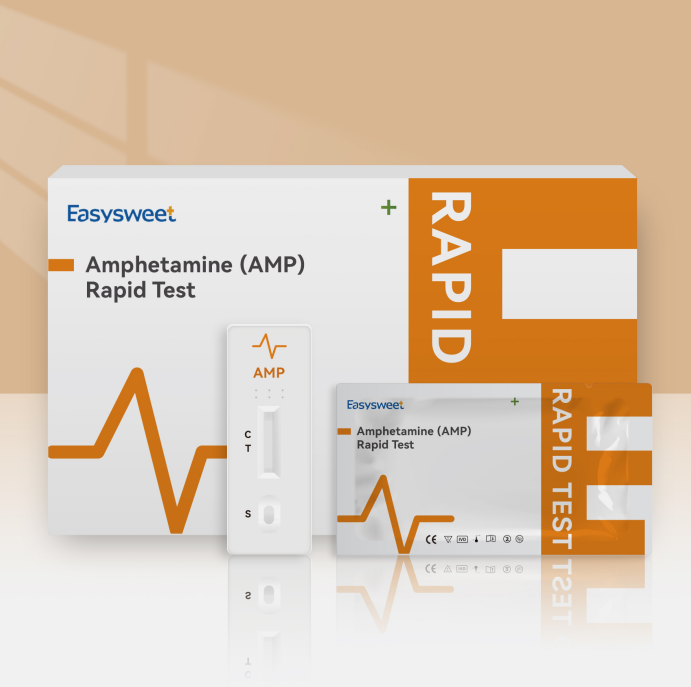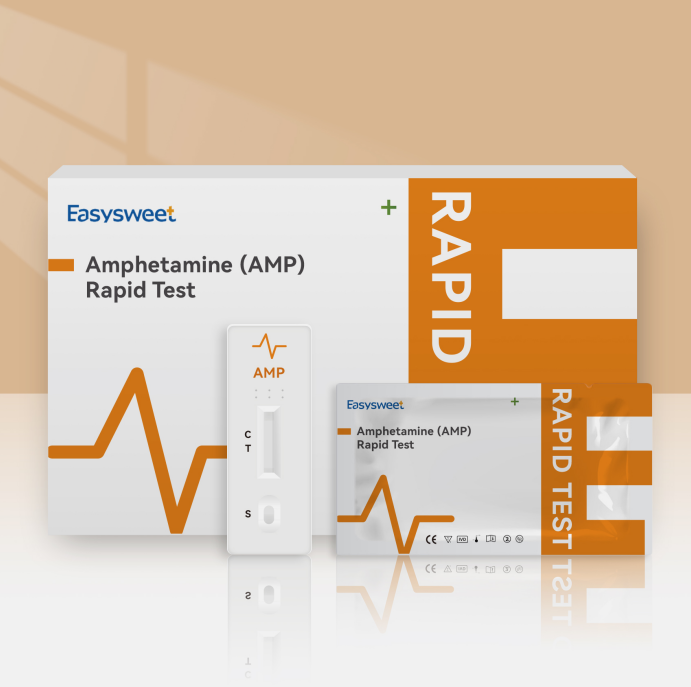The Amphetamine (AMP) Rapid Test is a rapid screening test used to qualitatively detect specific critical levels of amphetamines and metabolites in human urine.
【Intended Use】
The Easysweet Amphetamine (AMP) Rapid Test is an immunochromatographic method used to qualitatively determine the presence of the amphetamines (AMP) listed in the table below.

This assay provides preliminary analytical test results only. Gas chromatography/mass spectrometry (GC/MS) is the preferred method of confirmation. Clinical consideration and professional judgment should be exercised regarding amphetamines of abuse (AMP) test results, especially when indicating a preliminary positive result.
Amphetamines and structurally related "designer" drugs are sympathomimetic amines whose biological effects include potent central nervous system (CNS) stimulation, anorexia, hyperthermia, and cardiovascular properties. They are usually taken orally, intravenously, or smoked. Amphetamine is readily absorbed from the gastrointestinal tract, then inactivated by the liver or excreted unchanged in the urine, with a half-life of approximately 12 hours. It can be detected in urine 1 to 2 days after use. Amphetamine is metabolized to deaminated (hippuric and benzoic acids) and hydroxylated metabolites. Methamphetamine is partially metabolized to amphetamine and its main active metabolite. Amphetamines increase heart rate and blood pressure, and suppress appetite.
【in Principle】
The Easysweet Amphetamine (AMP) Rapid Test is a competitive immunoassay for screening urine for the presence of amphetamine (AMP) and metabolites. It is a chromatographic absorption device in which a drug in a urine sample competes for binding with a limited number of drug monoclonal antibody (mouse) binding sites.
When the test is initiated, urine is absorbed into the test by capillary action, mixed with the corresponding drug monoclonal antibody conjugate, and passed through the pre-coated membrane. When the drug in the urine sample is below the detection level of the test, the corresponding drug monoclonal antibody conjugate binds to the corresponding drug-protein conjugate immobilized in the test area (T) of the test. This produces a colored test line in the test area (T) of the test that indicates a negative test result, regardless of its intensity.
When the sample drug level is equal to or higher than the detection level of the test, the free drug in the sample binds to the corresponding drug monoclonal antibody conjugate, preventing the corresponding drug monoclonal antibody conjugate from binding to the corresponding drug immobilized in the test- Region (T) of the protein conjugate binding device. This prevents a distinct colored band from appearing in the test area, indicating a preliminary positive result.
As a program control, if the test has been performed correctly, a colored line will appear in the control area (C) of the test.
【Interpretation of results】
Preliminary positive (+)
Only one colored band appears in the control area (C). No colored bands appear in the test area (T).
negative (-)
Two colored bands appeared on the membrane. One band appears in the control area (C) and the other band appears in the test area (T).
Invalid
If a color band is not visible in the control region or a color band is only visible in the test
region, the test is invalid. Another test should be run to re-evaluate the specimen. If test
still fails, please contact the distributor or the store, where you bought the product, with
the lot number.
Note: There is no meaning attributed to line color intensity or width.
QUALITY CONTROL
Though there is an internal procedural control line in the test device of Control region,the use of external controls is strongly recommended as good laboratory testing practice to confirm the test procedure and to verify proper test performance. Positive and negative control should give the expected results. When testing the positive and negative control, the same assay procedure should be adopted.
If there is any infringement, please contact us.


